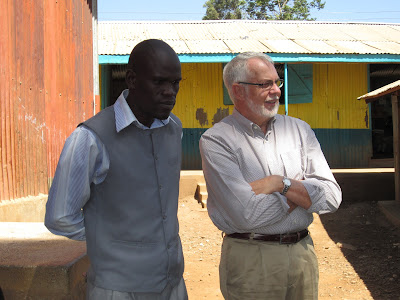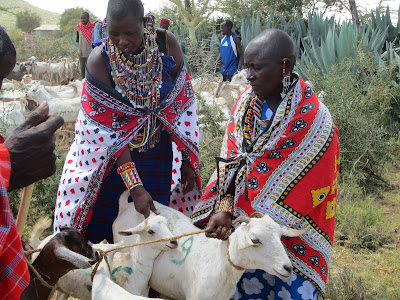Yes, day 1 came after a long journey from Canada. We had met up for the first time at the Jomo Kenyatta International Airport the previous evening. Long awaited introductions happened quickly as we wound our way to the Mennonite Guest House (in a most reliable bus with a very competent James at the wheel) down the dark Uhuru Highway of Nairobi – a trip that took only about a half hour at this time of night, yet would end up taking much more time when the traffic was out and about during the day.
Most of us did not need the knife clanking away on the xylophone in order to wake up for breakfast. Our internal clocks had not yet made the appropriate adjustments causing many of us to be awake for many an hour already. Breakfast was most tasty. Excellent granola made on site! I for one would love that recipe. This is a good start. If the food continues on like this, it will help a lot!
After breakfast we make our way (by foot) to the MCC offices which were just 15 minutes or so down the road. This walk is our introduction to Africa in the sunlight. There are people walking everywhere. There is the smell of burning garbage. One must always keep an eye out for where one walks as the surface of the road and walkways are not consistent.
Ron and Martha were waiting patiently for us when we arrived and then introduced us to the variety of programs that were part of MCC Kenya’s portfolio.
After about an hour at the office, we headed out by bus to visit the tea farm. Yes, this day was going to be our first taste of rural Africa – after all, Nairobi is only 15 minutes out of Africa.
We’re still all being pretty careful with each other. First impressions can be so important. No need to misstep at this early stage – at least one hopes not to. Our road to the tea farm is uphill – it feels like all the way. For Adelia and myself, there is much anticipation as we are off to visit our dear friend Fiona who lost her husband in a traffic accident less than three months earlier.
We drive past the first set of tea fields. Such a lovely green – almost manicured. Actually they are.
Tea gets picked year round, sometimes as often as every 7 to 10 days, and in the cooler dryer season, maybe only every two weeks. It used to be that they picked only two leafs and a bud, but over the past few years the tea processing plants have decided to take the top three leafs and a bud as the third leaf is also useable for tea, even if having a bit lower quality.
We arrive a half hour before our anticipated arrival time (traffic must have been working in our favour this morning). Fiona is doing last minute preparations in trying to get things in place (she certainly misses her husband Marcus who was always such a help). Adelia and I feel quite at home and take the group to her gardens where we begin (or was it continue) to share stories of our life in Africa. Thank you all for showing such interest.
At 11:00, Fiona welcomes us inside where she tells us the story of tea in Kenya and introduces different grades while we get to sip on the locally grown tea and munch on some homemade cookies.
An hour later Kimani leads us out to the indigenous forest where he explains the medicinal value of various plants and trees. No need to worry with him as our guide because he “knows his way out”.
We return to the farm house (which is actually a replacement for the original wood house that was eaten by termites) for drinks on the verandah. This is followed by a most delicious meal, all locally grown/raised finished off with home-made ice cream from the jersey cows. The food is an absolute delight. It seems to be getting better and better all the time. This certainly can’t continue.
The purpose of this day was three fold. First off it was to be a gentle introduction to Africa (Kenya light is how we sometimes refer to it). Actually it is more of a look back into history allowing us to get a bit of a window into those days of British colonialism prior to Kenya gaining its independence in 1963. Secondly, this day was to be a buffer for all of us as we work to get over the jet lag caused by an 8 hour (9 hour for the Winnipeggers, 10 hours for the Calgarian) time change. And third, it was a day where we started to get to know each other in a context that was quite new. It was an opportunity in a most relaxing setting of getting to know each other and make new friends.
A side benefit was that it also allowed for the first treasures to be purchased. We certainly hope you are enjoying them, Shelley and Stephanie.
By mid-afternoon we started our trek back to the Mennonite Guest House where many of us bedded down for an early night.













































